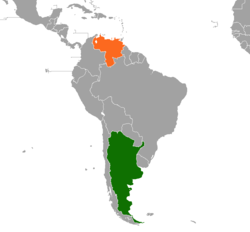| | |
 | |
| Total population | |
|---|---|
| 9,740 (2019) [1] | |
| Regions with significant populations | |
| Caracas, Maracaibo and Valencia | |
| Languages | |
| Religion | |
| Roman Catholicism | |
| Related ethnic groups | |
| Argentinians |
Argentine Venezuelans (Spanish : argentino-venezolanos) are Venezuelan citizens of partial or full Argentine descent, or Argentine citizens who have migrated to and settled in Venezuela. Many Argentines fled their country and settled in Venezuela during the military dictatorship that ruled Argentina from 1976 to 1983. In 2019, an estimate numbered Argentine Venezuelans still living in Venezuela at 9,740. [1]
